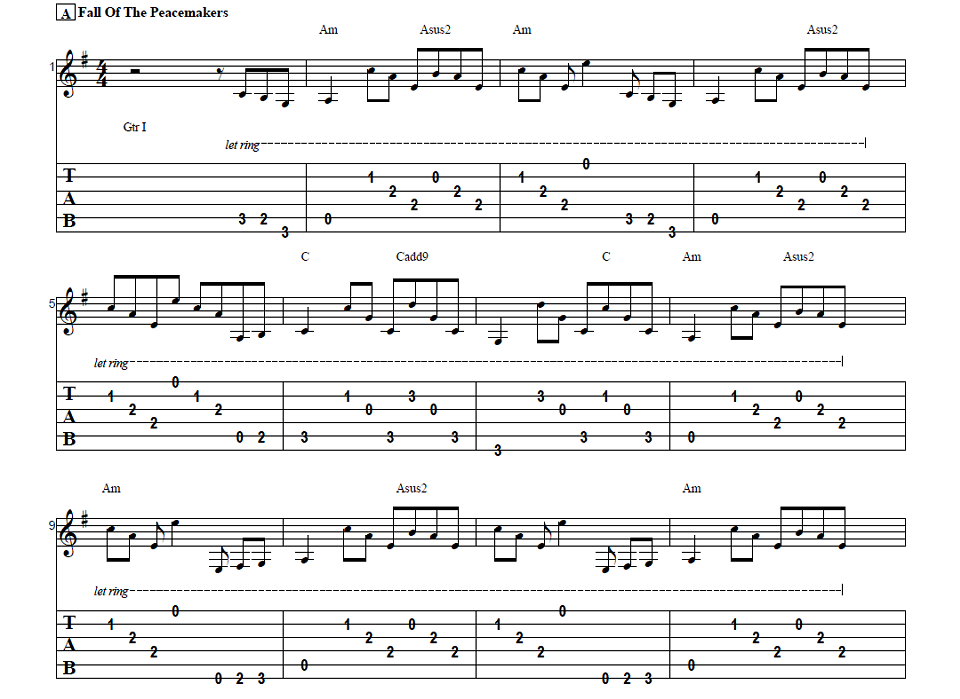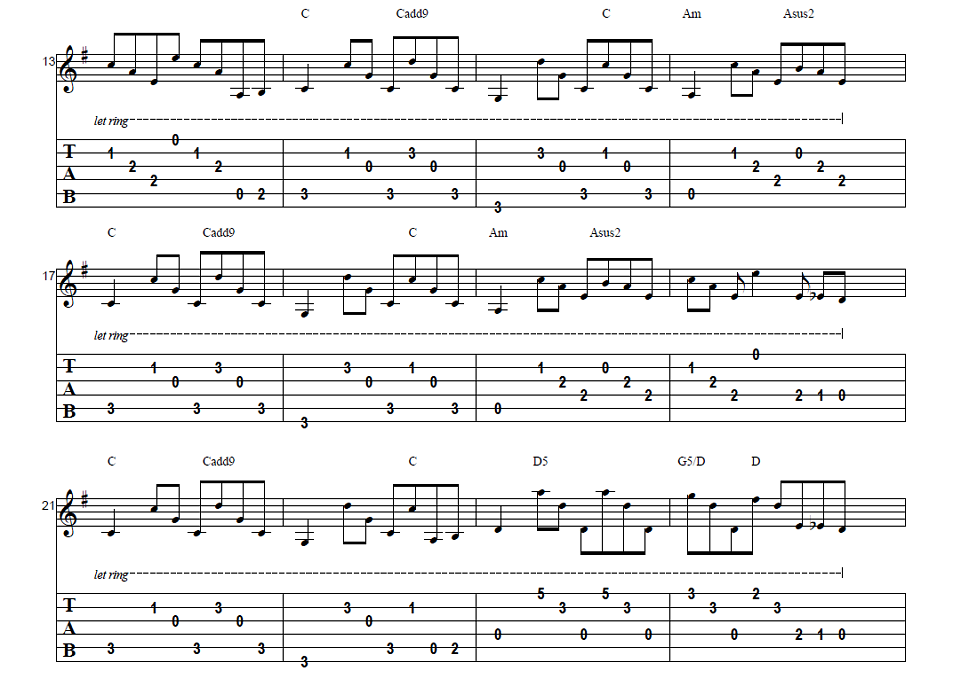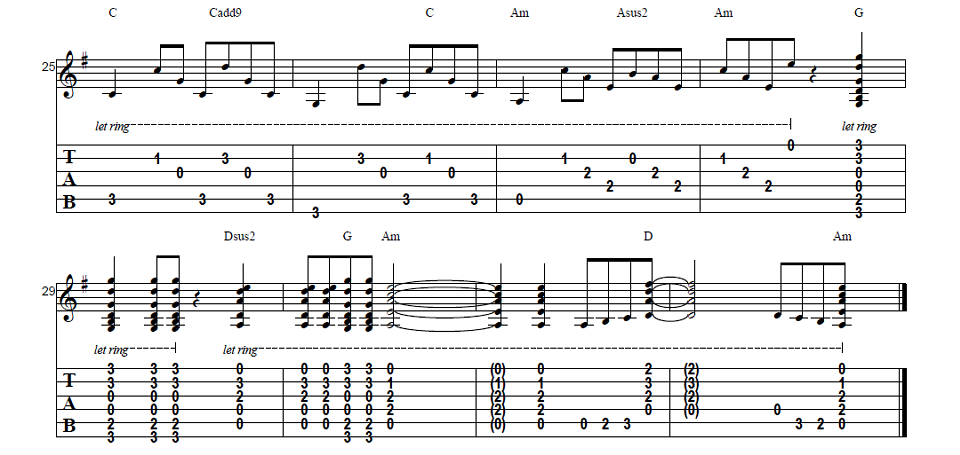Learn to play Fall Of The Peacemakers by Molly Hatchet with Guitar Control instructor Darrin Goodman, aka Uncle D. Be sure to get the free tabs to go a long with the step by step video instruction and you will be rockin’ this classic Milly Hatchet tune tonight!



Introduction
How’s it going everybody? This is Darrin with GuitarControl.com bringing you this video lesson and today I want to show you how to play Fall Of The Peacemakers by Molly Hatchet.
Right now Guitar Control is giving away a free chord chart. It’s a free download and there’s a link down in the description. Every chord you could ever need all neatly compiled into one PDF format chart that you can print it out and put it where you practice or put it in your gig bag. Any chord you could ever need at a glance and it’s a free download, click the link in the description.
So be sure to click on the link in the description for the tabs and let’s get close up and take a look at Fall Of The Peacemakers by Molly Hatchet .
Fall Of The Peacemakers – Molly Hatchet
All right so as far as like the chords and stuff go for this it’s all fairly simple, you know basic chords, but the tempo of this is really fast and it’s pretty difficult to play this at tempo. But even if you play it really slow it still sounds really good; so it’s like what I always say, you know just get the parts down, especially if there’s any parts that maybe there’s a particular transitions you’re having issues with, get those down and then just slowly work on getting the tempo.
All right so we’re going to start off, we’ve got an A minor (Am) chord and we’ve got these pickup notes that lead into it. So the first measure we rest on the first three beats, plus the first 16th note of beat four and we have these pickup notes. So what I’m doing is I put my fingers down you know for the Am chord and then use my second and third finger to do these pickup notes, but keep my first finger here on the first fret of the B string so that way I’m ready. So we’re starting here on the third fret of the A string and so this is the third sixteenth note of beat four so it’d be third fret of the A string to the second fret and then to the third fret of the low E string and then the downbeat of the second measure is just the open A string and it’s a quarter note, so that buys you just a second at a time to get your other two fingers back down for Am…
So we put our fingers down starting on beat two with eighth notes so we’re starting the B string, B to the G string is two and, and then the D string would be the downbeat of three… Okay now we’re gonna do an A suspended two (Asus2). So all we’re gonna do is just lift our first finger off and hit the B string, G string and D string again… so that’s the first two measures… And then starting on the third measure we just put our first finger back down again so it’s Am again, D, G, D and then the open high E string and we pick that on the and of two and it rings out for the downbeat of three and then on the and of three we’re going to go back and do that same starting on the A string on the third fret to the second fret to the third fret of the low E string and then it just it just kind of starts over again…
So we kind of think about Fall Of The Peacemakers by Molly Hatchet as it’s like different little sections of riffs that can kind of help you to memorize it. So after we do that, and that’s the in the fifth measure, the first three beats and then starting on beat four we’re going to play the open A string four, and on the and four to the second fret… so four and, and then to the third fret for one and at this time we’re going to be playing a C chord; so again just keep our first finger planted here on the first fret of the B string. So it’s like the pickup notes we had before, but now instead B, G, A string and then we got a C add 9 (Cadd9). So we’re just going to take our pinky and we’re going to put it onto the third fret of the B string to the G string and then back to the A string… so that’s one two and three and four and, and so that’s measure six and then for measure seven we’re going to keep that shape we got with the Cadd9 and we’re going to take our third finger we’re going to move it from the third fret of the A string to the third fret of the low E string and we’re going to more or less do the same thing we did in the previous measure, just the only difference is that the first note instead of being this C here on the third fret of the A string it’s this G on the third fret of the low E string, same picking. And then this is the part that’s probably the one of the trickier parts. We hit this bass note B and G and then we have to move that finger back up to the C there on the third fret of the A string and that’s coming on the downbeat of three; so it’s like one, two and, three and, four and, and then starting on the next measure we’re going to switch to an Am, so again our first finger doesn’t have to move from the first fret of the B string, we switch to Am and now we’re going to pick A on the downbeat of one and then on the downbeat of two B string and of two G string down to the B string to the D string and then we take our first finger off for and four and. So the B string becomes open so it’s more or less the same picking technique and pattern that we used when we were revolving around the Am at the beginning with the Am. All right so then starting there again on measure seven; third finger onto the third fret low E string and our fourth finger still here on the third fret of the B string, our first finger is still on the first fret of the B string… so remember we go… and then we have to move that finger back down to the Am – Asus2. Now Am again on measure nine and then the whole open high E string so when we come back and hit that open high E string that’s kind of the end of that phrase and we start on the next part. All right so measure nine on the and of three we got new pickup notes, so it’s the low E string open, but again I’m going to keep my first finger here on the first fret of the B string; so we have open to the second fret to the third fret and four and, and then on the downbeat of measure nine beat one quarter note is the open A string and then we’ve got that same Am – Asus2 riff again and then just repeat same pickup notes…
Now we’re going to go back and do like what we did before; so the pickup notes are now the open A string to the second fret, to the third fret. Now we’re doing the C, Cadd9 and then that where we take our third finger and move it to this G on the third fret of the low E string… move that third finger back to the C there to the Am, Asus2 ,C, Cadd9, G bass note and then the Am – Asus2 thing again…
All right, so up to that point in Fall Of The Peacemakers by Molly Hatchet it’s like there’s three separate little riff ideas that you do, so you just want to memorize each one of those at a time and then and then put it together. So now we are on measure 20 and this is our next big change. So we we’re coming off of that Am – Asus2 thing… now our pickup notes are the second fret of the D string which your second finger is already on to the first fret with your first finger and then the string open and then it’s going to go back to the C – Cadd9 riff. So starting on measure 19… to the C, Cadd9, that G bass note on the third fret of the low E string and then back to the C…
Okay now this is where the next big change is. So this last phrase was probably the shortest one… so there on measure 22 we hit the first fret of the B string there on the and of three and then on the downbeat of four it’s the A string open four, the and of four is the second fret and then to the open D string. Okay so now we’re going to go to A, D voicing, but it’s not like this D voicing… it’s actually like a power chord, it’s a D5. So this transition we’re going to come up to that, so what we’re going to do is we’re going to come up and put our first finger on to the third fret of the B string and we’re going to put our third finger onto the fifth fret of the high E string. So now we’re going to pick the open D string on beat one of measure 23 and then on the downbeat of two it’s the high E string, and of two is the B string, back to the D again on the downbeat of three; so it’s like one, two and, three and, four and… Then on the next measure what we’re going to do is we’re just going to take our first finger and we’re going to lay it down flat so it’s going across the third fret of the high E string and the B string and same picking E, B, open D string and then the chord is going to change again and now we’re going to put our second finger onto the third fret of the B string and our first finger on the second fret of the high E string… and then that little chromatic two, one, open again. So let’s just play that whole phrase. So we’re starting at the last part of, let’s see measure 20. So I start with that little chromatic movement so I’m on the second fret of the D string with my second finger to the first fret to the open string to the C, Cadd9, that G bass note on the third fret of the low E string, move it back… and now we have to make that jump up to this chord… and then back to that again. So that part is really weird, especially when you play this part by yourself. If you’re playing it slower that chromatic part just sounds really weird, when it’s up to tempo, it comes by really quick so you don’t notice it as much, but it does sound kind of weird. All right so back to a C, Cadd9, bass note to G and move it back to the C, Am, Asus2, Am. All right, so that is the actually the end of where they’re arpeggiating and then it goes into some strumming at that point.
So coming out of this is like one and two and three four and we rest on beat three and we go to a G, so that’s four and then on measure 29 one, two and, three, we rest on three, so four, one, two and, three and then we’re gonna go to a Dsus2. So Dsus2 is just your D chord with the high E string open. So when we’re switching from this voicing of G to that our third finger is already here on the third fret of the B string. So we’re coming from that G… we hit that on four; four, one and, two and, three. So the Dsus2, four one and to switch to G two and switch to Am three four and that’s a half note and that’s tied to the first beat of the next measure, so that’s like three four one two and then on three open A string three. The and of three is the second fret, the downbeat of four is the third fret, so same pickup notes from before to D. So we’re hitting that three and four and, and then that’s tied to the first two beats of the next measure three and four and one two and then the downbeat of three open D string three the end of two is the third fret of the A string, the downbeat of four is the second fret. So with the pickup notes and then we end on Am… And that is that is basically like the whole intro section. Fall Of The Peacemakers by Molly Hatchet is pretty long and then when they when it goes into the vocals it’s just a lot of these same riffs just repeated.
Conclusion
All right so there you have it, Fall Of The Peacemakers by Molly Hatchet. So if you like this lesson be sure to give me a thumbs up and leave a comment down below if you have any questions about this or other guitar related topics. If you haven’t already done so please subscribe to the channel and hit that notification bell so you don’t miss any of the content that we upload throughout the week. Well that is all I have for you today. Thanks for watching how to play Fall Of The Peacemakers by Molly Hatchet and have a great day.



